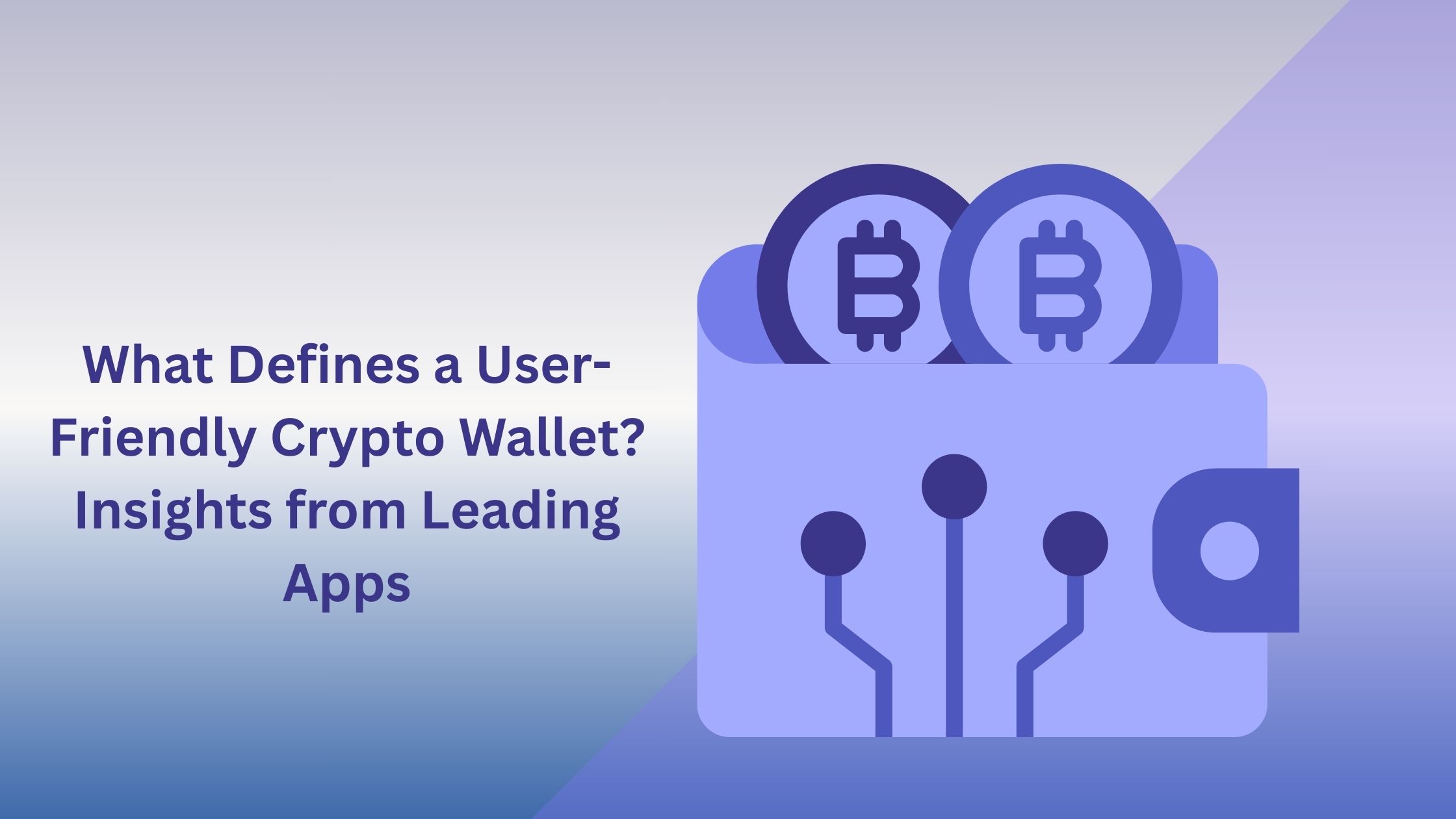In the world of cryptocurrency, a user-friendly wallet is the key to successful engagement for both new users and seasoned traders. A good crypto wallet allows users to store, send, and receive their digital assets in a straightforward, secure, and efficient way. But what exactly makes a crypto wallet ‘user-friendly’? As the industry grows, the need for wallets that are intuitive and accessible to a wider audience is becoming more important than ever.
In this article, we’ll break down the key factors that make a crypto wallet easy to use, using insights from the best apps in the market today.
What is a Crypto Wallet?
Before we dive into what makes a wallet user-friendly, let’s quickly clarify what a crypto wallet is. A cryptocurrency wallet is a tool that allows users to interact with blockchain networks, store digital currencies, and manage private keys. While the concept of a wallet is similar to that of a traditional one, the experience is often far more complex due to the technical nature of blockchain technology.
There are two primary types of crypto wallets:
- Hot Wallets: These wallets are connected to the internet and allow quick access to funds for regular trading or transactions. Examples include mobile apps, browser extensions, and online platforms.
- Cold Wallets: These are offline wallets used for long-term storage of digital assets. They are considered more secure but are less convenient for frequent use.
Now, let’s talk about what truly sets a crypto wallet apart when it comes to user experience.
Key Factors That Make a Crypto Wallet User-Friendly
A user-friendly crypto wallet is essential for both beginners and experienced users to manage their digital assets securely and efficiently. In crypto wallet app development, focusing on key features like simplicity, security, and transparency greatly enhances the overall experience.
1. Intuitive Interface
A user-friendly crypto wallet starts with a clean, easy-to-navigate interface. For beginners, the crypto world can feel overwhelming, so the design of the wallet should aim to simplify complex processes.
Simple Dashboard
The dashboard of the wallet is often the first thing users interact with, so keeping it clutter-free is essential. A well-organized dashboard presents the most crucial information (like balances, transaction history, and recent activity) without overwhelming the user with technical jargon.
Top apps, like Coinbase and Exodus, use clear and simple interfaces to ensure that users can quickly understand the state of their funds, recent transactions, and other key features at a glance.
Easy-to-Find Features
From transferring funds to checking price charts or viewing transaction details, users should be able to find the features they need without hunting through layers of menus. Easy access to frequently used functions like sending, receiving, or converting cryptocurrencies is a hallmark of user-centric design.
For example, Trust Wallet places the Send and Receive buttons prominently on the homepage, making it clear where users can begin transactions.
2. Easy Setup and Onboarding
A crypto wallet should not require hours of tutorials or complex setup processes. One of the biggest barriers to entry for new crypto users is the technical nature of wallets. To lower the entry threshold, wallets must have easy onboarding processes that guide users through account creation, key generation, and the first deposit.
Clear Instructions
Wallets like MetaMask offer a smooth onboarding experience with easy-to-follow instructions. They walk users through the steps of creating a wallet, saving the recovery phrase (which is essential for restoring the wallet), and adding their first assets. Clear explanations about what each step means—especially in terms of security—make it easier for beginners to feel confident.
Streamlined Registration
Quick registration without unnecessary steps is a major factor in keeping users happy. Simple email/password registration or integration with existing social media profiles allows users to sign up quickly without needing extensive personal details.
Many wallets also offer one-click sign-ins or biometric authentication, such as face or fingerprint recognition, to make login seamless and secure.
3. Security Features
Security is paramount when it comes to managing digital assets. A user-friendly crypto wallet must balance convenience with robust security measures. After all, users want an app that makes it easy to access their assets but also prevents unauthorized access.
Multi-Factor Authentication (MFA)
Top crypto wallets, such as Ledger Live and Coinomi, offer multi-factor authentication (MFA). This adds an extra layer of protection by requiring users to confirm their identity through two or more verification methods, such as a password, biometric data, or an authenticator app. It ensures that even if one factor is compromised, the wallet remains secure.
Backup and Recovery Options
One of the main concerns for crypto users is losing access to their wallet. A wallet that offers easy recovery options, such as a mnemonic phrase or backup key, ensures that users can regain access in case they lose their device or forget their password. Exodus Wallet is a good example, as it makes it clear how to back up recovery phrases during the initial setup process.
Encryption and Private Key Management
Your private keys should remain private. Many wallets today implement top-notch encryption techniques, keeping private keys secure both on your device and in transit. Trezor is a well-known hardware wallet that offers robust key management and encryption features.
4. Smooth Transactions and Low Fees
One of the main reasons users turn to crypto wallets is to send or receive digital currencies easily. The wallet’s transaction process should be smooth and transparent.
Transparent Fees
A user-friendly wallet should make transaction fees clear before the transaction is initiated. Some wallets like Blockchain Wallet even provide an option to customize the fee, allowing users to prioritize faster transactions for a higher fee or slower ones for lower costs.
Speed of Transactions
Crypto wallets should aim to minimize transaction times, especially on networks with slower processing speeds, like Bitcoin. Some wallets, such as Trust Wallet, offer options to select which blockchain network to use for specific transactions (for example, opting for faster transactions via Ethereum over Bitcoin).
5. Support for Multiple Cryptocurrencies
For users who hold various digital assets, the ability to store and manage multiple cryptocurrencies within the same wallet is essential. A wallet that only supports one cryptocurrency limits its users, while a multi-asset wallet provides flexibility and convenience.
Wide Asset Support
Apps like Exodus and Coinomi provide support for hundreds of cryptocurrencies, from popular assets like Bitcoin and Ethereum to niche tokens. Users should also be able to swap between cryptocurrencies with ease, reducing the friction involved in asset management.
Wallets that provide integration with DeFi platforms and allow users to manage not only their tokens but also NFTs and smart contracts can greatly enhance their experience. MetaMask, for example, integrates seamlessly with Ethereum-based decentralized applications (dApps), giving users access to a broad ecosystem of decentralized services.
6. Mobile and Desktop Compatibility
In today’s fast-paced world, crypto users want access to their wallets on the go. A user-friendly crypto wallet development must offer a mobile app that is as easy to use as its desktop counterpart.
Mobile Experience
The mobile app developers should provide all the essential features found in the desktop version while adapting to a smaller screen. Apps like Trust Wallet and Coinbase Wallet have mobile-first designs that make it easy for users to check balances, send crypto, or exchange tokens while on the move.
Desktop Version for Power Users
For advanced users who may want to interact with their wallets while working on their computer, a desktop version of the wallet can be a game-changer. Many crypto wallets, like Exodus, also offer desktop applications that sync with mobile devices, ensuring a seamless experience regardless of the device being used.
7. Customer Support and Help Resources
Even the most user-friendly crypto wallet will likely need to address user issues at some point. Having an accessible support system in place can go a long way toward improving the overall user experience.
Access to Support
Wallets like Coinbase and Binance provide multiple support options, including 24/7 live chat, email support, and a robust help center filled with FAQs. The faster and more responsive the customer service team, the better the experience for users when they encounter an issue.
Educational Resources
Many users, especially beginners, appreciate wallets that offer tutorials, FAQs, and even video guides. Wallets like Exodus do a great job of providing in-app tips and tutorials, walking users through the app’s features step by step.
8. Regular Updates and Improvements
A truly user-friendly wallet is not static; it evolves with the needs of its users. Regular updates and improvements help to fix bugs, introduce new features, and improve security.
Bug Fixes and New Features
Wallets like MetaMask and Trust Wallet frequently release updates that not only fix issues but also add new functionalities. By listening to user feedback and adapting to market changes, these apps maintain their user-friendliness over time.
9. Low Maintenance and Energy Efficiency
Crypto wallets should not drain a user’s battery life or consume excessive resources on their device. A good crypto wallet operates efficiently, even when the user has multiple apps running.
Battery-Friendly
Apps like Exodus optimize battery usage and avoid running unnecessary background tasks. This is particularly important for mobile users who rely on their phones for everyday activities.
Minimal Device Resource Usage
Efficient resource management ensures that the app runs smoothly without impacting other apps or the device’s performance.
Conclusion
A user-friendly crypto wallet simplifies the complex world of cryptocurrencies while maintaining a high standard of security and usability. By focusing on an intuitive interface, secure features, low transaction fees, multi-asset support, and reliable customer service, top apps like Coinbase, Trust Wallet, and MetaMask have set the standard for what it means to be truly user-friendly.


